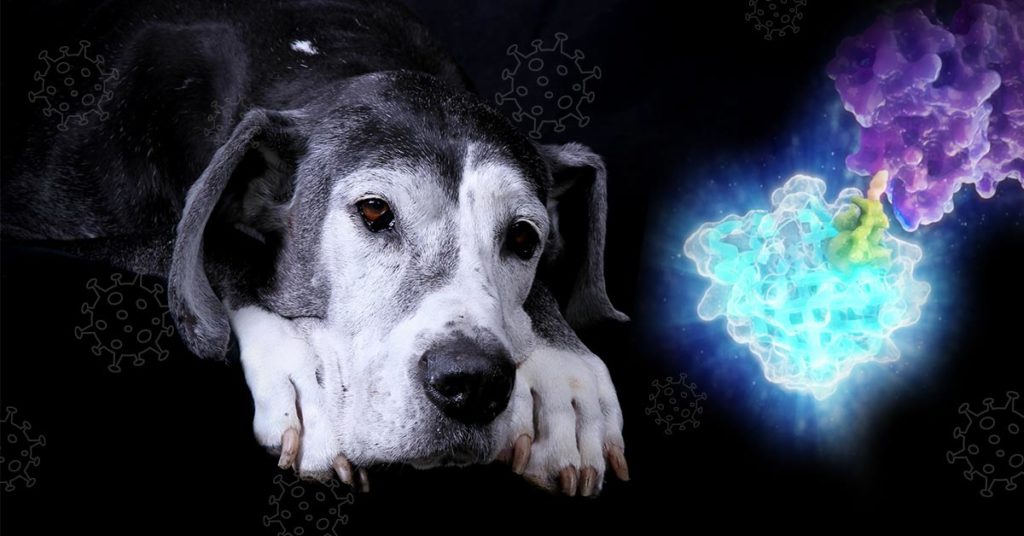
Canine distemper virus (CDV) is a highly contagious pathogen that is the etiological agent responsible for canine distemper (CD), a systemic disease that affects a broad spectrum of both domestic dogs and wild carnivores. While there are commercially available vaccines for CDV that can provide immunity in vivo and protect canines from contracting CD, there is a strong demand for effective canine distemper antivirals to combat outbreaks. Such drugs remain unavailable to date, largely due to the laborious, time-consuming nature of methods traditionally used for high-throughput drug screening of anti-CDV drugs in vitro. In a recent study published in Frontiers in Veterinary Science, researchers demonstrated a new tool for rapid, high-throughput screening of anti-CDV drugs: a NanoLuc® luciferase-tagged CDV.
Deadly Distemper
Canine distemper is a brutal, highly contagious disease that impacts the respiratory, gastrointestinal and central nervous systems of those unlucky enough to contract it. The disease is often fatal, and those that do survive typically have permanent and irreparable nervous system damage. Symptoms typically begin with watery or pus-like discharge from the eyes and a fever, build up to coughing, lethargy, vomiting, and culminate with neurologic symptoms, including circling behavior, salivation and chewing movements of the jaw (“chewing-gum fits”), convulsions, seizures, and partial or complete paralysis.
In wildlife, the symptoms of CD can appear to closely resemble rabies and there is a large number of species who are susceptible to canine distemper infection, including not only members of the Canidae family (coyotes, foxes, wolves), but also members of Procyonidae (raccoons), Mustelidae (skunks, minks, badgers, otters) and large Felidae (lions, tigers, leopards).
The canine distemper virus is most commonly spread through airborne exposure (coughing or sneezing) from an infected animal, but it can also be transmitted through shared food and water bowls or equipment or passed via an infected mother’s placenta to her puppies.
At the moment, the best way to combat CD for your pet is prevention through vaccinations, which help prepare their immune systems to fight against potential CDV infections. Typically this involves a series of shots that are administered to 6-week old puppies at 3- to 4-week intervals up until they are 16 weeks old, plus one shot a year later, and then booster shots every 1 to 3 years after that, depending on the type of vaccine. One of the most common CD-preventative vaccines used is a actually a 5 in 1 called DHPP, which prevents not only distemper, but also parvovirus, parainfluenza and two types of adenovirus (aka hepatitis).
There is currently no cure for CD infections, and the typical treatment route consists mainly of supportive care and management of the more severe symptoms to limit secondary infections. Due to this and the ease of viral spread between the large number of susceptible wild animal populations populations as well as with domestic dogs, there is a consistent demand for commercially available anti-viral drugs to help address CD outbreaks.
An Illuminated Approach to Screening
Currently, there are a number of drugs that have demonstrated anti-CDV characteristics, however none of them have been approved to use in clinical therapeutic treatment of CD. Conventional screening methods of anti-CDV drugs in vitro are cumbersome, so in the Frontiers in Veterinary Science study, the researchers utilized reverse genetics technique and NanoLuc® luciferase as a different approach to the problem.
Reverse genetics is a method that has been commonly used to construct recombinant CDVs to express foreign proteins and has been used in CDV research for over 20 years. In this time, CDV has been used as a vector for expression of a variety of foreign proteins, from rabies virus glycoproteins to reporter genes such as fluorescence proteins to firefly luciferase.

Luciferases are excellent reporter genes, as their expression level generally implies viral replication kinetics. NanoLuc® luciferase (NLuc), an enzyme engineered for optimal performance as a luminescent reporter gene, has been utilized successfully in other studies to construct recombinant viruses for antiviral assays and imaging.
To facilitate CDV drug screening in vitro, the researchers first rescued, identified, and characterized a recombinant NLuc-tagged CDV plasmid (rCDV-NLuc), which they then used in anti-CDV assays on four drugs via luciferase activity analysis: the nucleoside analog ribavirin (RIB), moroxydine hydrochloride (MOR), 1-adamantylamine hydrochloride (AMA) and tea polyphenol (TP).
Optimistic Outcomes
One of the most common methods for anti-CDV drug screening is the 50% tissue culture infective dose (TCID50) assay, which can be used alone or in conjunction with other quantitative assays like RT-qPCR and Western blots to determine the 50% effective concentration (EC50) of a drug. The EC50 is then used to determine the anti-CDV effectiveness which can be described in terms of the selectivity index, or SI. This complete process is not effective as a rapid tool, as it both time-consuming (requiring at least 5 to 7 days) and labor-consuming (requiring intra-references for quantitative analysis).
Using their novel, rapid method with the rCDV-NLuc construct, the researchers were able to complete a luminescence-based EC50 assay within an hour for each drug. The method also eliminated the need for intra-references, which both simplifies the process and saves time.
They observed a positive correlation between the expression of NLuc and the propagation of rCDV-NLuc in vitro within 48 hours post infection (hpi), indicating that the intensity of the luminescence can indirectly reflect the anti-CDV effect of a certain drug within 48 hpi. These results indicate that the rCDV-NLuc-based method has high-throughput potential for drug screening.
Using this method, the researchers were able to confirm that one of the drugs, RIB demonstrated a detectable anti-CDV effect via luciferase assay analysis instead of the traditional TCID50 assay. They determined that the antiviral effect (described in terms of SI value), was 14.2 for RIB against CDV. As an SI value ≥ 4 is the general benchmark for suitability of an antiviral drug, the 14.2 result confirmed RIB as an ideal canine distemper antiviral. Though MOR, AMA and TP are effective anti-influenza drugs that have displayed some anti-CDV characteristics, the individual luminescence assays for these three drugs showed that they were unable to inhibit replication of rCDV-NLuc, indicating they are not good candidates for anti-CDV treatment.
Although the novel, luciferase-based method described in this study is a promising solution for high-throughput screening for canine distemper (CDV) antivirals, the authors noted that the inability of drugs to interfere with NLuc expression makes quantifying the effect of an anti-CDV drug difficult. The technique could work well as a prescreening technique for anti-CDV agents and still help accelerate anti-CDV compound screening.
References:
- Liu, F. et al. (2020) Recovery of NanoLuc Luciferase-Tagged Canine Distemper Virus for Facilitating Rapid Screening of Antivirals in vitro. Front. Vet. Sci. 7:600796. https://doi.org/10.3389/fvets.2020.600796
- Merck Manual: Veterinary Manual. Canine Distemper Overview.
- American Veterinary Medical Association. Canine Distemper.
